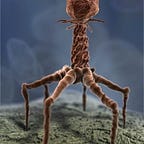Quantum Biology
Biologists don’t really like to think about physics. They take the requisite physics courses as an undergraduate, and then thank the science gods that they no longer have to worry about Einstein, Maxwell, and Newton. And the majority of biologists do not need to worry about quantum physics; they look at molecules on such a large scale that they do not need to know anything beyond the basics of quantum mechanics. The ball-and-stick model of molecules will suffice when you are examining the interactions between trillions of organic molecules. Physicists study quantum mechanics in vacuums near absolute zero; in the warm, messy environment of a cell, it has long been believed that quantum effects can be largely ignored.
But some scientists have suggested that there are some biological phenomena that can only be explained by quantum mechanics. In his influential book, What is Life? (1944), Erwin Schrödinger postulated that quantum mechanics could meaningfully impact cellular functions. He guessed that genetic material might be kept and inherited by storing information in different quantum states. Although Watson and Crick would later identify DNA as the carrier of genetic information, Schrödinger opened up the door for quantum biology.
Quantum Tunnelling
Recently, carefully designed experiments have provided evidence that quantum biology impacts life in a very meaningful way. Enzymes, the catalysts of reactions in the cell, have been shown to utilize quantum tunnelling. By this mechanism, enzymes can move an electron or proton from one part of a molecule to another.
Quantum tunnelling provides a quick and efficient way for enzymes to rearrange molecules to facilitate reactions. This movement cannot be explained through classical physics. Quantum probabilities and duality are essential to the understanding of these reactions.
Quantum tunneling can also play a role in the mutations of DNA. DNA is a double-stranded molecule in which the two strands are held together by hydrogen bonds. These bonds can be pictured below:
The white atoms are hydrogen. This A-T bond contains two hydrogen bonds. It is believed that the hydrogen atoms can “jump” across to the other side via quantum tunnelling. If the strands of DNA are separated while the hydrogen has jumped across to the opposite side, these strands may not replicate or transcribe correctly. This mutation due to hydrogen tunneling could potentially cause disease.
Quantum Coherence
Photosynthesis is one of life’s most essential processes. When a photon of light strikes a pigment, the photon is absorbed and an electron is freed. That electron then enters the electron transport chain, which builds up a chemical charge that can be used to generate ATP. But in order to enter the electron transport chain, the electron must move from the point where the photon frees it, through the chlorophyll, to a point called the reaction center. There are multiple pathways this electron can take to reach the reaction center.
By using the principles of quantum coherence and entanglement, electrons can take the most efficient pathway possible without losing energy to heat. Quantum coherence states that electrons, because they exhibit wave-like properties, can move in multiple directions at the same time. Electrons are therefore capable of taking multiple different pathways simultaneously to reach the reaction center. This phenomenon allows for the optimal transfer of energy.
Quantum coherence may effect other aspects of life. Some scientists theorize that the human retina uses coherence to transmit signals from the eye to the brain. They cite the fact that photoisomerization, the change in structure of the photon receptor, occurs so quickly that only quantum coherence can account for the speed. There may be many biochemical pathways which use quantum phenomena, just waiting to be discovered.
Quantum Entanglement
Entanglement is one of the most difficult concepts to understand in quantum mechanics. It describes the interactions between two or more quantum particles. Although it is not yet verified, it is believed that quantum entanglement may be able to explain magnetoreception. Magnetoreception is the ability of organisms to detect and align themselves with a magnetic field. Birds and other animals use this ability to sense the Earth’s magnetic field and migrate. The exact mechanism for this behavior has long been a mystery. It is possible that the earth’s magnetic field affects the radical pair mechanism within the retina, and the entanglement between the radical pair can provide a quantum signal to organisms, acting as a compass.
Looking Ahead
Quantum mechanics may influence many more biochemical functions. Some believe that olfaction, or how we smell, may be due to the quantum vibration of molecules. Other research indicates that quantum mechanics is involved in Brownian motors within the cell. Quantum biology is still an extremely young field, but it appears that there is massive room for growth. We should all keep our eyes on this interesting field.
“If quantum mechanics hasn’t profoundly shocked you, you haven’t understood it yet.” — Niels Bohr
Special thanks to Jim Al-Khalili and TedTalks for information and images used in this article. For more posts about disease and biology, subscribe to Cell Your Soul. Feel free to comment below or message your feedback!
